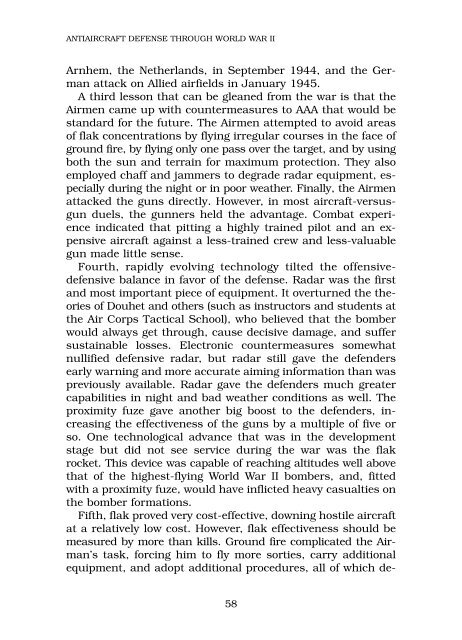Archie to SAM: A Short Operational History of Ground-Based Air ...
Archie to SAM: A Short Operational History of Ground-Based Air ...
Archie to SAM: A Short Operational History of Ground-Based Air ...
You also want an ePaper? Increase the reach of your titles
YUMPU automatically turns print PDFs into web optimized ePapers that Google loves.
ANTIAIRCRAFT DEFENSE THROUGH WORLD WAR II<br />
Arnhem, the Netherlands, in September 1944, and the German<br />
attack on Allied airfields in January 1945.<br />
A third lesson that can be gleaned from the war is that the<br />
<strong>Air</strong>men came up with countermeasures <strong>to</strong> AAA that would be<br />
standard for the future. The <strong>Air</strong>men attempted <strong>to</strong> avoid areas<br />
<strong>of</strong> flak concentrations by flying irregular courses in the face <strong>of</strong><br />
ground fire, by flying only one pass over the target, and by using<br />
both the sun and terrain for maximum protection. They also<br />
employed chaff and jammers <strong>to</strong> degrade radar equipment, especially<br />
during the night or in poor weather. Finally, the <strong>Air</strong>men<br />
attacked the guns directly. However, in most aircraft-versusgun<br />
duels, the gunners held the advantage. Combat experience<br />
indicated that pitting a highly trained pilot and an expensive<br />
aircraft against a less-trained crew and less-valuable<br />
gun made little sense.<br />
Fourth, rapidly evolving technology tilted the <strong>of</strong>fensivedefensive<br />
balance in favor <strong>of</strong> the defense. Radar was the first<br />
and most important piece <strong>of</strong> equipment. It overturned the theories<br />
<strong>of</strong> Douhet and others (such as instruc<strong>to</strong>rs and students at<br />
the <strong>Air</strong> Corps Tactical School), who believed that the bomber<br />
would always get through, cause decisive damage, and suffer<br />
sustainable losses. Electronic countermeasures somewhat<br />
nullified defensive radar, but radar still gave the defenders<br />
early warning and more accurate aiming information than was<br />
previously available. Radar gave the defenders much greater<br />
capabilities in night and bad weather conditions as well. The<br />
proximity fuze gave another big boost <strong>to</strong> the defenders, increasing<br />
the effectiveness <strong>of</strong> the guns by a multiple <strong>of</strong> five or<br />
so. One technological advance that was in the development<br />
stage but did not see service during the war was the flak<br />
rocket. This device was capable <strong>of</strong> reaching altitudes well above<br />
that <strong>of</strong> the highest-flying World War II bombers, and, fitted<br />
with a proximity fuze, would have inflicted heavy casualties on<br />
the bomber formations.<br />
Fifth, flak proved very cost-effective, downing hostile aircraft<br />
at a relatively low cost. However, flak effectiveness should be<br />
measured by more than kills. <strong>Ground</strong> fire complicated the <strong>Air</strong>man’s<br />
task, forcing him <strong>to</strong> fly more sorties, carry additional<br />
equipment, and adopt additional procedures, all <strong>of</strong> which de-<br />
58
















